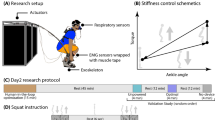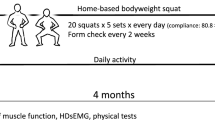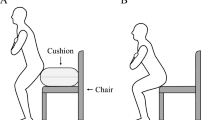Abstract
The mass and strength of skeletal muscles decrease with increasing age, especially those of the knee extensor muscles. For elderly people, the decrease in force-generation capability of the knee extensor muscles reduces their ability to perform activities of daily life. Hence, the maintenance and/or improvement of knee extensor muscle strength is very important for elderly individuals. Home-based squat training without any special equipment or venue is considered to be useful for preventing age-related decreases in strength of the knee extensor muscles. The current study was designed to develop an administration system for elderly people to routinely perform body mass-based squat training at home. The characteristics of the new system are the use of onomatopoeia to allow participants to self-check their movements during squat training, and the provision of feedback functions for maintaining motivation towards the training. We performed an experiment to test the validity of our vision using a pilot version of the administration system. However, clear effectiveness of our proposed system was not proven. In this experiment, we used onomatopoeia for only one position, despite the fact that onomatopoeia are useful for evaluating and focusing upon differences in movements involving multiple joints. Hence, it is reasonable to assume that the full benefit of onomatopoeia was not realized with the current experimental design. Judging from the current results, our plan related to this system requires further refinements.
You have full access to this open access chapter, Download conference paper PDF
Similar content being viewed by others
Keywords
1 Introduction
It is well known that the mass and strength of skeletal muscles decrease with increasing age, especially those of the knee extensor muscles (Candow and Chilibeck 2005; Kubo et al. 2007; Overend et al. 1992). For elderly people, the decrease in force-generation capability of the knee extensor muscles reduces their ability to perform activities of daily life, such as walking (Kim et al. 2000) and standing up from a chair (Hughes et al. 1996). Hence, the maintenance and/or improvement of knee extensor muscle strength is important for elderly individuals.
Resistance training is effective for preventing this age-related decrease in muscle strength. For example, many people may consider going to a training gym to routinely perform resistance training, because of the availability of special equipment and professional trainers. However, this is not convenient or practical for everybody. In addition, for people without the appropriate knowledge of resistance training methods, it can be dangerous to perform resistance training using such equipment. Taken together, resistance training at a training gym is not a universal solution, especially for elderly people.
There is a possibility that squat training improves the strength of the knee extensor muscles. Here, we investigated the effectiveness of promoting body mass squat training at home and without special equipment, in order to reduce injury risks, while facilitating continuation of the training. Our previous study (Ema et al. 2017) identified two problems with such resistance training: (1) Elderly people cannot easily check their own movements during squat training, and (2) It is difficult for elderly people to maintain their motivation towards home-based squat training. In order to address these problems, the current study aimed to develop a new promotion system for home-based squat training that includes automated feedback and support.
Performing squat training with correct form is important for reducing the risk of injury and maximizing the training effect. Hence, a system that enables users to objectively confirm their training motion is thus desirable. A smartphone or tablet can easily be used to capture moving images while performing the home-based squat training. Moreover, if an objective evaluation of the motion during exercise is automatically generated, based on the moving images, users can check their own motion. In addition, users should be able to easily interpret the evaluation of the motion. One possible approach to help with users’ comprehension is to use onomatopoeia. Onomatopoeia are words whose sound is imitative of a sound made by or associated with its referent, such as “bang”, “bow-wow”, etc. In the new system, we incorporated onomatopoeia in a video of squat training recorded using a smartphone and/or a tablet camera. Moreover, we tried to maintain the motivation for users to train, because training interruption can induce a decrease in muscle strength among elderly individuals. The current study thus aimed to develop an administration system for elderly individuals to routinely perform body mass-based squat training at home.
2 System Summary
2.1 Sensors
A method for monitoring the speed of body movements in training is required, because the relationship between the speed and comprehension of onomatopoeia is a significant point on the feedback video. In order to obtain the speed data, we designed a wearable device incorporating 3-axis magnetic accelerometers and gravity sensors, to evaluate joint position, angle, angular velocity and acceleration. We also considered affordability and ease-of-use in the device and interface design, as follows: (1) the sensor and the video environment are easy to obtain; (2) the price of the sensor and the video system are low; (3) the sensors are small enough to affix to the hip and knee joints; (4) the video system can be easily installed; and (5) manipulation of the sensors and the video can be managed by elderly individuals. We used hook-and-loop fastener tape for the sensors, to make them easily attachable and detachable, and adopted video capture equipment such as a smartphone on a tripod or a webcam for visual monitoring.
2.2 Onomatopoeia
Based on the sensor data, our system generates a visual transformation in which the shape or size of a relatable image, i.e., the characters of onomatopoeia, changes as a training hint, assisting comprehension of the correct or required movement. First, because our system is used for squat exercises, we selected the word “Gu” as the onomatopoeia because this word can enable Japanese users to instinctively evaluate the degree of their effort. The displayed character size and shape transform according to the joint angle and its change, respectively. For example, if a joint is flexed rapidly, a large and thin letter is displayed, and vice versa. Additionally, the color of the character changes based on the presence or absence of motion. A red character is used during squatting, and a green character when standing. These visual effects were intended to help users understand their body posture and movement speed. Furthermore, by imparting onomatopoeia to each of the joints involved in the physical exercise, users can obtain information about each joint motion and can understand the overall motion of their bodies. Therefore, the onomatopoeia transformation can express differences in the movements of plural joints by using different sizes, speeds and angles.
As shown in Fig. 1, the user’s squatting motion and characters of onomatopoeia for each joint are simultaneously displayed on the screen of a smartphone or tablet with our web application installed. Users are able to check their overall motion from the squat animation displayed on the left side. The web application has a zoom function that enables users to easily distinguish the precise differences between joint motions based on the changes in character size and shape of onomatopoeia. By selecting a specific body part, an enlarged view of interest is displayed in the right side of the display. The degree of magnification can be adjusted using a slide bar.
2.3 Feedback
In addition to the combined use of animation and onomatopoeia, a real time feedback function was designed to help users visualize their efforts to train. As shown in Fig. 2, users record an animation with a smartphone or tablet. The video data are automatically transmitted to a cloud and onomatopoeia are added to the training motion of the animation data. After finishing the training session, the user can start a web application to confirm their motions with onomatopoeia. If they performed the squat exercise accurately, the character size of the onomatopoeia changes smoothly (Fig. 3(b)). The onomatopoeia shown in Fig. 3(a) indicates an inaccurate form during squat exercise. As shown in the conceptual diagram (Fig. 4), we can compare the two animations displayed on the web application: one is a sample animation of the experienced instructor, and the other is the users’ animation during the squat exercise.
A second feedback function indicates the improvement of muscle strength. Users perform muscle strength testing every month using a dynamometer (CON-TREX MJ, PHYSIOMED, Germany) and the results are stored in the proposed system and shown as a graph. This function is designed to maintain and/or increase motivation regarding the continuation of home-based squat training among elderly users.
3 Pre-study
In the pre-study, we first verified the operation of the web application. The participant was a young male. To quantify the joint position and angular velocity during squatting, the sensor devices were attached to the greater trochanter, knee joint cleft and lateral malleolus. The participant performed several squat repetitions, and we recorded the motion.
The web application identified the sensors as the center of rotation of each joint, and detected the position and angular velocity of the sensors. Thus, we confirmed that the squat motion can be quantified appropriately by using the web application, and that an animation with onomatopoeia based on the device data of devices could be generated.
4 Experiment
4.1 Participants
Eight young men participated in the study (age: 23 ± 1 year; body height: 172.3 ± 5.8 cm; body mass: 65.3 ± 9.1 kg; mean ± standard deviation). The participants were divided randomly into two groups in order to evaluate the usefulness of the feedback function with onomatopoeia for improvement of squat motion. In both groups, the squat motion was recorded from a sagittal plane. In Group A, the participants were able to check their own motion using the feedback function, which displays the squat animation superimposed by numerical data of joint position and angular velocity (Fig. 5). In Group B, the squat animation with onomatopoeia, intended to help the user instinctively understand their joint position and angular velocity, was used as an alternate feedback function (Fig. 6). The character size of the onomatopoeia represented the joint angle and angular velocity. Specifically, the font size was small when the knee joint was extended, and increased in size with knee flexion. In addition, to indicate a standing position, the character color changed with hip position. When the device attached to greater trochanter was in the initial highest position (i.e., standing), the character became orange (Fig. 7). In other positions, the character was red (Fig. 8). The participants in this experiment had received no direct instruction on squat training from an athletic trainer, but they had some information about squat form.
4.2 Protocol
In order to evaluate the improvement of squat motion, all participants performed squat exercise four times for two days. Considering the difference in knee extensor strength between young and elderly individuals (Overend et al. 1992; Kubo et al. 2007), a 20 kg barbell was used as a load in this experiment. As in the pre-study, the sensor devices were attached to the greater trochanter, knee joint cleft and lateral malleolus. Before the squat training on the second day, the participants viewed their own motion from the first day using the feedback function. They then established a learning objective for the second day by comparing their own squat animations with numerical data (Group A) or onomatopoeia (Group B) with those of the experienced instructor. For instance, if they felt that their hip position at the lowest point of the squat on the first day was higher than the posture of the instructor, they set an objective to try to lower their hips. After the training, we interviewed the participants as to what extent were they able to achieve their learning objective, based on viewing their training motion from the second day.
4.3 Results and Discussion
In Group A, three participants were able to achieve their learning targets (Table 1). They indicated that the position of the waist during the downward phase of the squat exercise was easy to understand. This seemed to be due to the display of the joint angles. In contrast, it was difficult for the members of Group A to perform squat exercises at a constant speed because of the time-course changes in the displays of joint angle and angular velocity.
In Group B, two participants were able to achieve their learning targets (Table 1). It was easy for the participants of Group B to instinctively understand the differences in motion during squat exercise between the downward and upward phases, because of the displayed onomatopoeia. However, two participants could not achieve their learning objectives. In this experiment, we displayed onomatopoeia in only one position. As described above, however, the use of onomatopoeia is effective for expressing differences in movements of plural joints. In other words, the full benefit of onomatopoeia may have been difficult to realize using the current experimental design. We thus could not demonstrate a clear difference in the usefulness of the system between Groups A and B.
5 Conclusion
We proposed a new administration system for elderly individuals to routinely perform body mass-based squat training at home. The characteristics of this system are to include onomatopoeia and real time or long-term feedback functions. Judging from the results of our experiment, however, our plan requires further refinements.
References
Candow, D.G., Chilibeck, P.D.: Differences in size, strength, and power of upper and lower body muscle groups in young and older men. J. Gerontol. A Biol. Sci. Med. 60, 148–156 (2005)
Ema, R., Ohki, S., Takayama, H., Kobayashi, Y., Akagi, R.: Effect of calf-raise training on rapid force production and balance ability in elderly men. J. Appl. Physiol. 123, 424–433 (2017)
Fujino, Y., Kikkawa, M., Sagisaka, Y.: A collection of onomatopoeias in Japanese sports. In: Oriental COCOSDA International Cordinating Committee on Speech Datavases and Speech I/O System Assessment, pp. 160–164 (2003)
Hughes, M.A., Myers, B.S., Schenkman, M.L.: The role of strength in rising from a chair in the functionally impaired elderly. J. Biomech. 29, 1509–1513 (1996)
Kim, J.D., et al.: Relationship between reduction of hip joint and thigh muscle and walking ability in elderly people. Jpn. J. Phys. Fitness Sports Med. 49, 589–596 (2000). [In Japanese]
Kubo, K., Ishida, Y., Komuro, T., Tsunoda, N., Kanehisa, H., Fukunaga, T.: Age-related differences in the force generation capabilities and tendon extensibilities of knee extensors and plantar flexors in men. J. Gerontol. A Biol. Sci. Med. 62, 1252–1258 (2007)
Overend, T.J., Cunningham, D.A., Kramer, J.F., Lefcoe, M.S., Paterson, D.H.: Knee extensor and knee flexor strength: cross-sectional area ratios in young and elderly men. J. Gerontol. 47, M204–M210 (1992)
Acknowledgements
This study was partly supported by JSPS KAKENHI (Grant Number: JP17KK0174).
Author information
Authors and Affiliations
Corresponding author
Editor information
Editors and Affiliations
Ethics declarations
The authors declare that this research was conducted in the absence of any commercial or financial relationships that could be construed as a potential conflict of interest.
Rights and permissions
Copyright information
© 2019 Springer Nature Switzerland AG
About this paper
Cite this paper
Hirasawa, Y., Ishioka, T., Gotoda, N., Hirata, K., Akagi, R. (2019). Development of a Promotion System for Home-Based Squat Training for Elderly People. In: Yamamoto, S., Mori, H. (eds) Human Interface and the Management of Information. Information in Intelligent Systems. HCII 2019. Lecture Notes in Computer Science(), vol 11570. Springer, Cham. https://doi.org/10.1007/978-3-030-22649-7_39
Download citation
DOI: https://doi.org/10.1007/978-3-030-22649-7_39
Published:
Publisher Name: Springer, Cham
Print ISBN: 978-3-030-22648-0
Online ISBN: 978-3-030-22649-7
eBook Packages: Computer ScienceComputer Science (R0)












